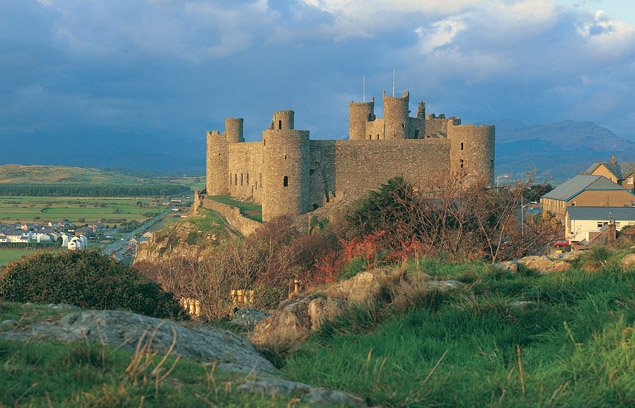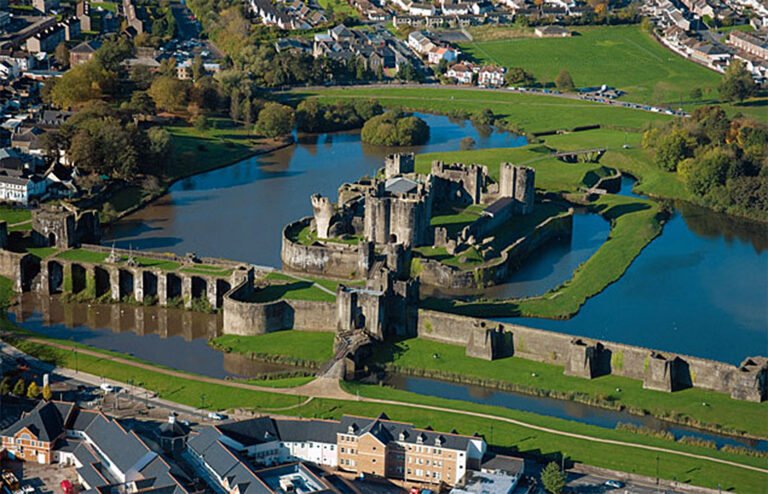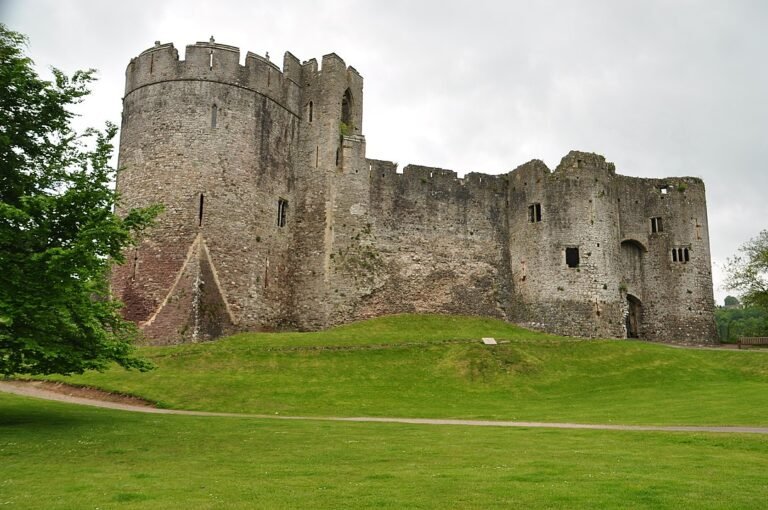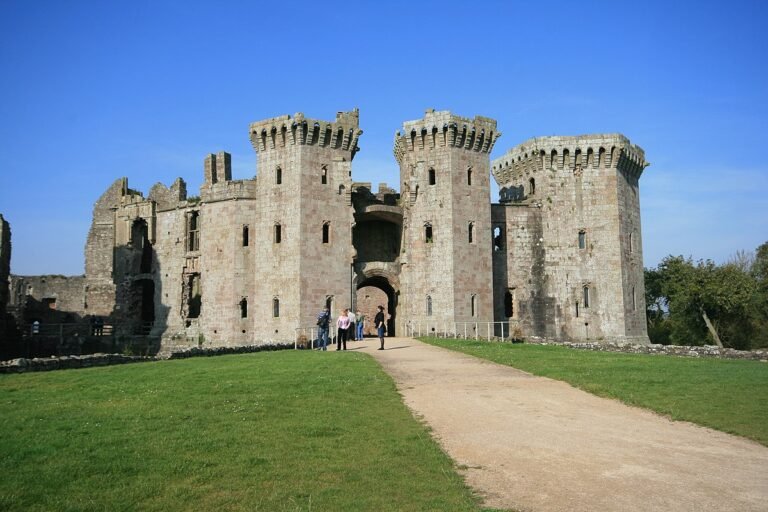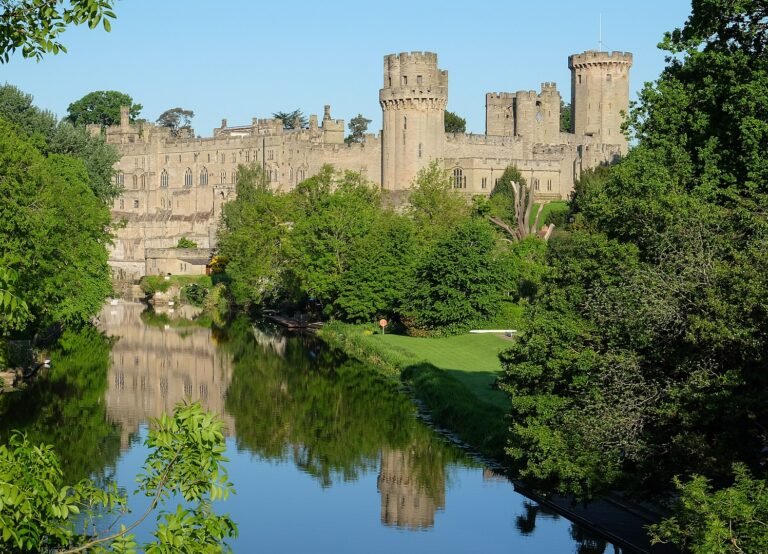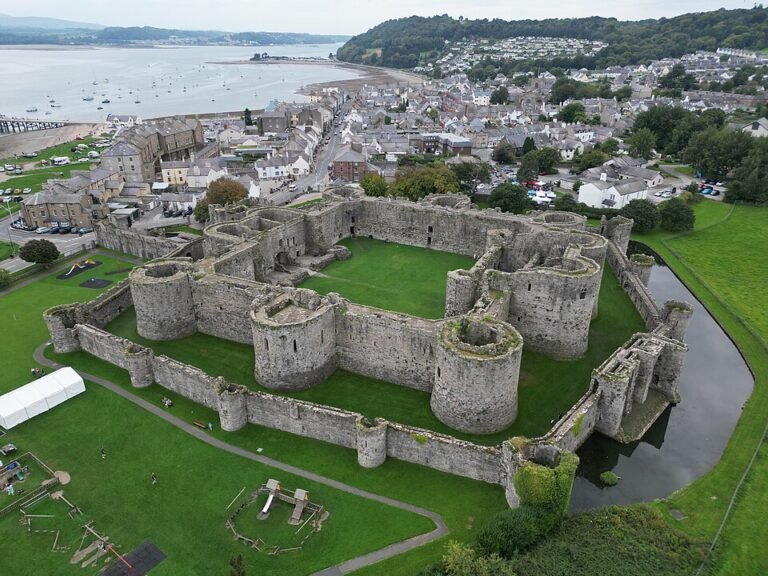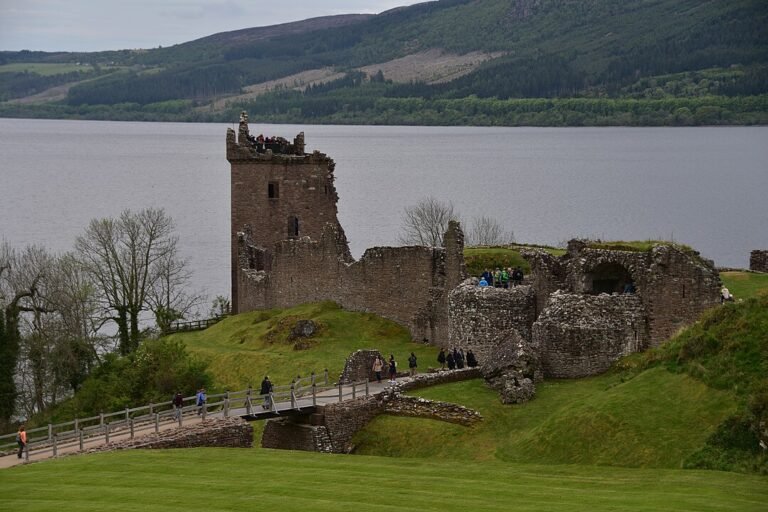Harlech Castle: Exploring Wales’ Mighty Mountain Fortress
Introduction to Harlech Castle
Harlech Castle stands proudly atop a rocky crag in Gwynedd, North Wales, commanding breathtaking views over Cardigan Bay and the distant peaks of Snowdonia. This UNESCO World Heritage Site is one of Edward I’s iconic “Iron Ring” of castles, designed to assert English rule over the Welsh. Its dramatic position, rich military history, and architectural prowess make it a highlight of any Wales itinerary.
Harlech Castle: Historical Background
Constructed between 1283 and 1290 by Master James of St. George, Harlech Castle played a central role in England’s conquest of Wales. Designed for defence and intimidation, it featured concentric walls, a massive gatehouse, and a protected sea route for resupply. The castle withstood several sieges, including during Owain Glyndŵr’s rebellion in the early 15th century and the Wars of the Roses.
Its last military use came during the English Civil War, when it was held by Royalists before surrendering in 1647. Since then, it has become a symbol of Welsh resilience and national pride, famously inspiring the song “Men of Harlech.”
Harlech Castle: Key Facts and Features
- Location: Harlech, Gwynedd, LL46 2YH, Wales
- UNESCO Status: Part of the Castles and Town Walls of King Edward in Gwynedd
- Opening Times (2025): Daily 10 am–4 pm (winter); 9:30 am–5:30 pm (summer)
- Tickets: Approx. £10.50 adults; Children: £7.60 family: £33.60 and concession rates available
- Managed by: Cadw, the Welsh Government’s historic environment service
What Makes Harlech Castle Unique?
Harlech Castle’s most striking feature is its dramatic setting atop a near-vertical cliff. Originally accessible via a water gate and long stairway down to the sea, this allowed for supplies and reinforcements by boat during sieges. Its symmetrical “walls within walls” layout, massive towers, and twin-towered gatehouse exemplify medieval military architecture at its peak.
From the battlements, you’ll enjoy panoramic views stretching across the Lleyn Peninsula, Snowdonia’s mountains, and the Irish Sea. Few castles in Britain combine natural drama and defensive design so effectively.
Major Attractions and Nearby Sights
On-Site Highlights
- The massive gatehouse, with towers you can climb for sweeping views
- The inner and outer wards, showing off concentric defences
- Interpretive displays and exhibitions in the visitor centre
- The famous “Way from the Sea” stairway, once used during sieges
Nearby Destinations
- Snowdonia National Park: Just minutes away, ideal for hiking, cycling, and scenic drives
- Portmeirion: A picturesque Italianate village just 20 minutes away
- Caernarfon Castle: Another of Edward I’s masterpieces, about an hour’s drive north
- Barmouth: Seaside town with sandy beaches and a historic bridge, 20 minutes south
Travel Tips and Practical Information
- By Car: Easily accessible via A496; paid parking available nearby
- By Train: Harlech station is a 5-minute walk from the castle, served by Transport for Wales
- Accessibility: The visitor centre is accessible, though the castle itself has uneven surfaces and steep steps
- Best Time to Visit: Spring and early autumn offer mild weather and fewer crowds
- Photography: Allowed throughout the site; sunrise and sunset shots from the battlements are especially rewarding
Suggested Itineraries
1-Day Harlech Explorer
- Morning: Tour Harlech Castle (2–3 hours)
- Lunch: Eat at Castle Cottage or Llew Glas Deli
- Afternoon: Walk along Harlech Beach or explore nearby Llandanwg Church
- Evening: Dine locally or watch sunset from the castle viewpoint
3-Day Heritage and Coast Trail
- Day 1: Harlech Castle, then drive to Portmeirion for a stroll and stay overnight
- Day 2: Explore Criccieth Castle and the beaches of Pwllheli
- Day 3: Visit Caernarfon Castle, then hike in Snowdonia (e.g., Llanberis Path)
Where to Eat and Stay
Dining Options
- Llew Glas Deli: Fresh local dishes and Welsh cakes
- Castle Cottage: Upscale dining next to the castle
- Y Branwen: Classic pub fare with a view
Accommodation
- Castle Cottage: Boutique stay next to Harlech Castle
- Y Branwen Hotel: Comfortable rooms with dining
- Min-y-Don Holiday Park: Ideal for families with sea views
Seasonal Events and Experiences
- Spring: Wildflower walks and local food festivals
- Summer: Outdoor theatre and medieval re-enactments at the castle
- Autumn: Fewer crowds and crisp coastal walks
- Winter: Quiet and atmospheric; some facilities may close
Broader UK Castle Connections
Harlech Castle is part of a grand tradition of British castles that includes:
- Edinburgh Castle: Dominates Scotland’s capital with royal history
- Conwy Castle: A nearby North Wales site with intact town walls
- Dover Castle: Key English stronghold overlooking the Channel
- Bamburgh Castle: Coastal fortress in Northumberland with dramatic views
Together, these sites reflect the UK’s rich tapestry of medieval, Tudor, and modern heritage tourism. They’re ideal for travellers interested in history, architecture, and landscape photography.
FAQs about Harlech Castle
Where is Harlech Castle located?
Harlech Castle is in Harlech, Gwynedd, overlooking Cardigan Bay and Snowdonia National Park in North Wales.
Who built Harlech Castle and when?
It was built between 1282 and 1289 by King Edward I, with a design by master architect James of St George.
Why is Harlech Castle significant?
It’s part of Edward I’s “Iron Ring” of castles and is recognised as a UNESCO World Heritage Site for its outstanding medieval military architecture.
Is Harlech Castle dog-friendly?
Yes, dogs on leads are welcome at Harlech Castle.
How do I get to Harlech Castle?
Harlech is accessible by car and train. The castle is a short walk from Harlech railway station and around a three-hour drive from Cardiff.
How long does a visit take?
Most visitors spend 1–2 hours exploring the castle, its towers, and panoramic battlements.
What else can I see nearby?
Nearby attractions include Harlech Beach, the Two Kings statue, St Tanwg’s Church, and local craft shops and cafes.
What role did Harlech Castle play in history?
The castle saw action during Madog ap Llywelyn’s revolt, Owain Glyndŵr’s rebellion, the Wars of the Roses, and the English Civil War. It inspired the Welsh song “Men of Harlech.”
Are there any interesting facts about Harlech Castle?
The castle once had a sea gate and stairway for resupplying during sieges. It is also linked to Branwen, a legendary figure from Welsh mythology.
Conclusion
Harlech Castle stands as a mighty monument to medieval ingenuity and the rugged beauty of Wales. With its strategic cliffside perch, deep-rooted history, and proximity to coastal and mountain adventures, it’s an essential stop for any UK travel itinerary. Whether you’re tracing Welsh legends, photographing castles, or simply soaking up the views, Harlech rewards every visitor with a story to tell.
